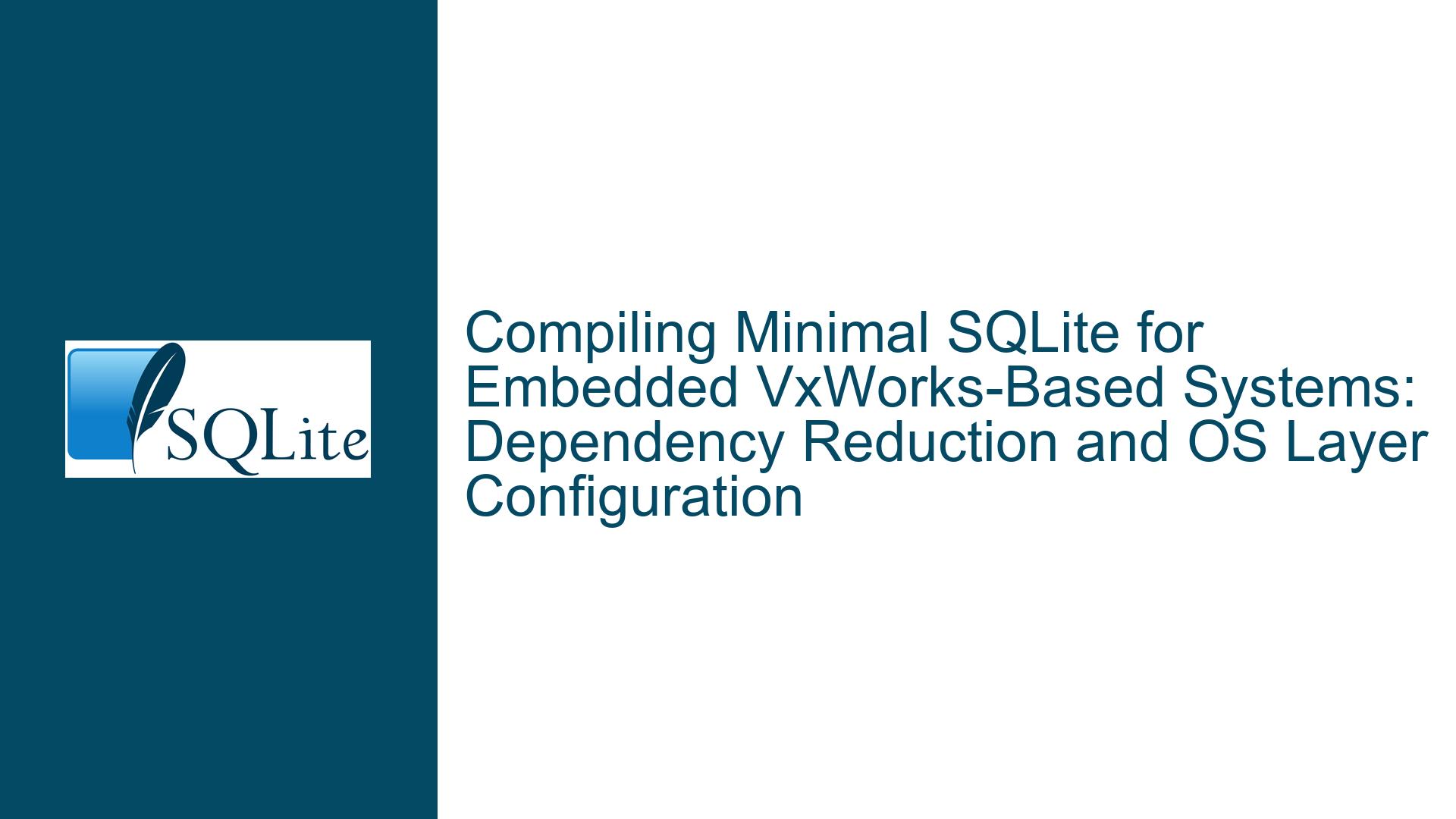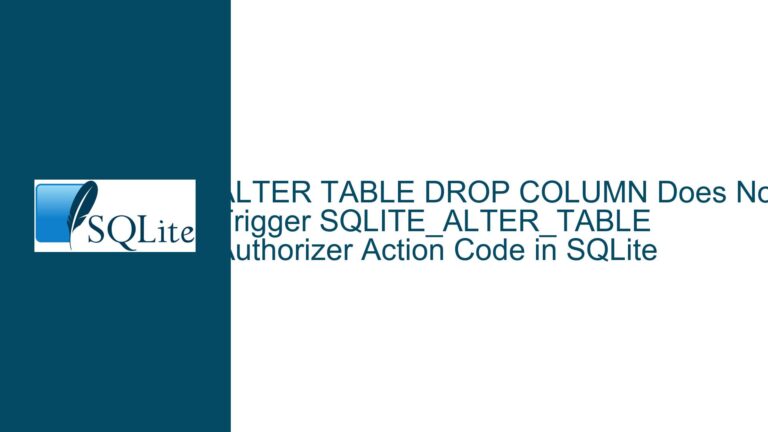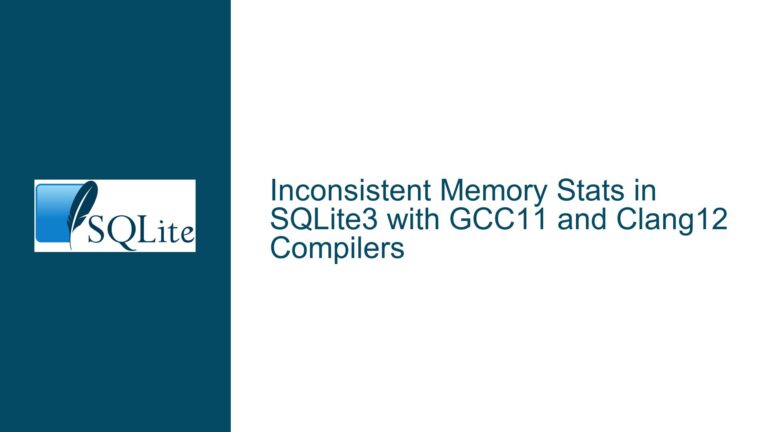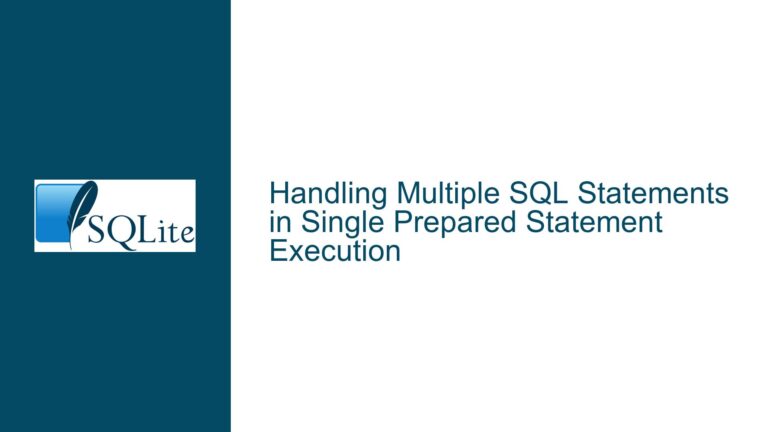Compiling Minimal SQLite for Embedded VxWorks-Based Systems: Dependency Reduction and OS Layer Configuration
Understanding SQLite’s Minimal Build Scope and Embedded System Requirements
The core issue revolves around configuring SQLite for an embedded system based on a custom VxWorks-like operating system while minimizing dependencies. The goal is to determine whether a minimal SQLite build restricts usage to in-memory databases and how to achieve such a build without requiring extensive custom implementations. This requires balancing SQLite’s dependency footprint against the need for functional database operations (both in-memory and file-based) in an environment with limited OS services.
SQLite’s "self-contained" build mode reduces external dependencies to basic C library functions (e.g., memcpy(), strlen()), but this does not inherently limit the database to in-memory usage. However, enabling non-memory operations (e.g., file I/O) introduces dependencies on the host OS’s Virtual File System (VFS) layer. In embedded systems lacking conventional OS services, configuring SQLite’s build flags and implementing a custom VFS or OS adaptation layer becomes critical. The challenge lies in identifying which SQLite features to disable or retain, and which OS abstraction layer components must be implemented to support the desired database functionality.
The discussion highlights two key points:
- In-memory databases require a default VFS to handle certain internal operations, even if no file I/O is performed.
- Using
-DSQLITE_OS_OTHER=1removes SQLite’s built-in OS dependency layer, but shifts responsibility for implementing OS-specific functions (e.g., file operations, process synchronization) to the developer.
This creates a tension between dependency reduction and the effort required to reimplement missing OS interfaces. For embedded systems, the optimal configuration depends on the availability of OS services (e.g., file systems, threads) and the developer’s willingness to implement SQLite’s OS abstraction layer.
Key Challenges: VFS Dependencies, OS Layer Gaps, and Build Misconfigurations
1. In-Memory Database Dependency on VFS
Contrary to intuition, in-memory databases (:memory:) in SQLite do not operate independently of the VFS layer. The default VFS provides infrastructure for features like shared cache, temporary tables, and database connections. Without a VFS, even in-memory databases may fail to initialize or exhibit undefined behavior. For example, the sqlite3_open_v2() function relies on the VFS to resolve the database’s storage backend. A minimal build that excludes the default VFS (e.g., unix or win32 VFS modules) forces the developer to provide a custom VFS, even for in-memory usage.
2. Ambiguity in SQLITE_OS_OTHER’s Scope
The -DSQLITE_OS_OTHER=1 flag disables SQLite’s built-in OS adaptation layer, which handles file operations, process synchronization, and memory management. While this reduces dependencies, it requires the developer to implement functions like sqlite3_vfs, sqlite3_os_init(), and sqlite3_os_end(). Misunderstanding the scope of these requirements can lead to linker errors (e.g., unresolved symbols for sqlite3_open()) or runtime crashes. For instance, if the OS lacks thread support, the build must also exclude threading features via -DSQLITE_THREADSAFE=0.
3. Over-Optimization Leading to Feature Loss
Aggressive dependency reduction (e.g., disabling the VFS entirely) can inadvertently remove features critical for basic operation. For example, disabling the VFS with -DSQLITE_OMIT_DISKIO restricts SQLite to in-memory databases but also removes utilities like temporary tables and the sqlite3_backup API. Similarly, omitting the memory management subsystem (-DSQLITE_OMIT_MEMORY_ALLOCATION) forces the use of a custom allocator, which is impractical for most embedded systems.
4. VxWorks-Specific Limitations
VxWorks’ real-time operating system (RTOS) environment often lacks POSIX-compliant file systems and process models. SQLite’s default Unix VFS assumes POSIX semantics, making it incompatible with VxWorks’ I/O subsystem. Developers must either:
- Port SQLite’s Unix VFS to VxWorks’ I/O API (e.g.,
open(),read(),write()). - Implement a custom VxWorks VFS from scratch.
- Use
SQLITE_OS_OTHERand provide stubs for required OS interfaces.
Each approach involves trade-offs between porting effort, performance, and feature support.
Configuration Strategies, OS Layer Implementation, and Validation
Step 1: Define Feature Requirements
Begin by auditing the embedded application’s SQLite usage:
- Required Features: Temporary tables, write-ahead logging (WAL), user-defined functions (UDFs).
- Storage Backends: In-memory only, file-based, or hybrid.
- Concurrency: Single-threaded, multi-threaded, or multi-process.
For example, if the application uses only in-memory databases and no temporary files, the build can exclude disk I/O (-DSQLITE_OMIT_DISKIO). However, this also disables features like ATTACH DATABASE and sqlite3_backup.
Step 2: Select Build Flags and VFS Mode
Use a combination of compile-time options to prune unneeded features:
# Minimal build with no OS layer and no disk I/O
-DSQLITE_OS_OTHER=1 -DSQLITE_OMIT_DISKIO -DSQLITE_THREADSAFE=0
If file I/O is required, retain SQLITE_OS_OTHER but implement a custom VFS:
# Custom VFS with file I/O support
-DSQLITE_OS_OTHER=1 -DSQLITE_THREADSAFE=0 -DSQLITE_ENABLE_MEMSYS3
The SQLITE_ENABLE_MEMSYS3 flag enables an alternative memory allocator, useful in systems without malloc().
Step 3: Implement OS Abstraction Layer
When using SQLITE_OS_OTHER, provide the following components:
Custom VFS Implementation
Define asqlite3_vfsstructure with function pointers for file operations:static int vxworksOpen(sqlite3_vfs *pVfs, const char *zName, sqlite3_file *pFile, int flags, int *pOutFlags) { // Map VxWorks I/O calls to SQLite's expected behavior } sqlite3_vfs vxworksVfs = { .iVersion = 3, .szOsFile = sizeof(VxWorksFile), .mxPathname = VXWORKS_MAX_PATH, .zName = "vxworks", .xOpen = vxworksOpen, .xDelete = vxworksDelete, // ... other function pointers };Register the VFS at startup:
sqlite3_vfs_register(&vxworksVfs, 1);OS Initialization and Shutdown
Implementsqlite3_os_init()andsqlite3_os_end()to manage resources:int sqlite3_os_init(void) { return SQLITE_OK; } int sqlite3_os_end(void) { return SQLITE_OK; }Memory Allocation Overrides (Optional)
If the system lacksmalloc(), define custom allocators:void *sqlite3_malloc(int size) { return myAlloc(size); } void sqlite3_free(void *ptr) { myFree(ptr); }
Step 4: Validate In-Memory and File-Based Operations
Test the minimal build with both in-memory and file-based databases to ensure the VFS and OS layer function correctly:
In-Memory Database Test
sqlite3 *db; int rc = sqlite3_open(":memory:", &db); if (rc != SQLITE_OK) { // Diagnose VFS registration or memory allocation failures }File-Based Database Test
rc = sqlite3_open_v2("test.db", &db, SQLITE_OPEN_READWRITE | SQLITE_OPEN_CREATE, "vxworks"); if (rc != SQLITE_OK) { // Check custom VFS implementation for file I/O errors }
Step 5: Optimize for Embedded Constraints
Further reduce code size and memory usage:
- Disable unneeded extensions:
-DSQLITE_OMIT_JSON,-DSQLITE_OMIT_TRIGGER. - Use a fixed-size memory allocator:
-DSQLITE_ENABLE_MEMSYS5. - Limit prepared statement complexity:
-DSQLITE_MAX_EXPR_DEPTH=10.
Step 6: Address VxWorks-Specific Quirks
- Non-POSIX File Systems: Map VxWorks file APIs (e.g.,
creat(),write()) to SQLite’s expected semantics. - Real-Time Priorities: Ensure the VFS does not introduce unbounded latency in file operations.
- Lack of Process Isolation: Disable features relying on file locking (
-DSQLITE_OMIT_SHARED_CACHE).
Step 7: Continuous Integration and Static Analysis
Embedded systems require rigorous validation:
- Use SQLite’s test suite (
make test) with custom harnesses for the target OS. - Perform static analysis (e.g., Clang’s
scan-build) to detect memory leaks or race conditions. - Profile memory usage with
sqlite3_status(SQLITE_STATUS_MEMORY_USED, ...).
By systematically evaluating feature requirements, selectively disabling SQLite components, and implementing only the necessary OS abstraction layer functions, developers can achieve a minimal SQLite build tailored to embedded VxWorks-like systems. This approach balances dependency reduction with the practical need for database functionality, avoiding over-optimization pitfalls while respecting resource constraints.






